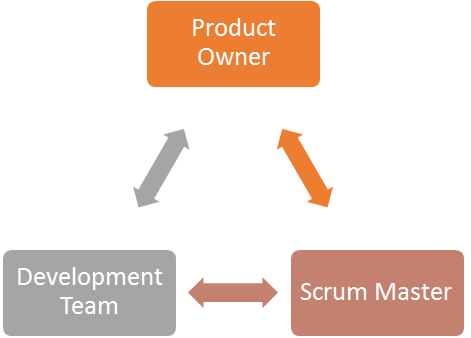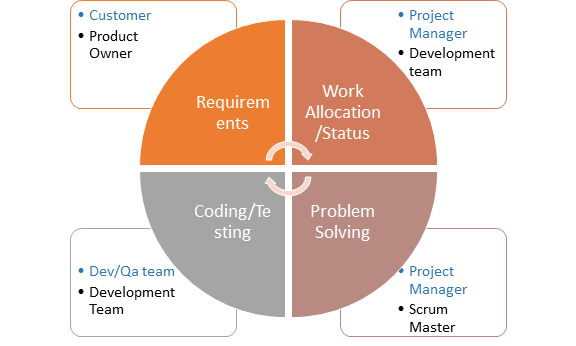Scrum, being the most used form of agile is famous in market. Even if organizations not using scrum in its true sense, few of scrum roles are used globally. Slowly market is trending towards calling Scrum roles as roles required in agile way of working. The problem with scrum knowledge these days is, there is too much information available and no guarantee what is right and what is wrong. In that scenario, knowing basics of Scrum roles and why it’s needed will give a good kick start for aspirants working or planning to start work in Scrum teams.
- PMI ACP Certification Exam preparation with agile practices
- Top 5 Agile certifications
- Scrum Practice Test
Scrum Roles
Full scrum process revolves around three components of it i.e. Scrum Roles, Scrum Artefacts and Scrum Ceremonies. In this article, we shall confine our discussion to only Scrum roles.
Scrum has defined only three roles as shown below:
Product Owner
In scrum, all the requirements are prioritized and kept in Product backlog from where team pick up the work and execute it. Product Owner is the custodian of this Product Backlog and ensure the features selected and developed in sprints are high in customer value. Product Owner is customer’s voice and any doubt on requirements or its prioritizations are solely owned by him.
Scrum recommends this role should be taken by one individual. Any kind of change in the backlog, which drives the team to take and execute work has to be discussed with Product Owner and s/he is the one who will take final call on it.
Scrum Master
Scrum master is most misunderstood role. Few technical organizations feel this role doesn’t add any value and few other feel this is the easiest thing to do for individual. In reality, this role is not easy at all. This person is a true servant leader who will ensure Scrum is followed and understood among the team members. As mentioned earlier, one important component of scrum is scrum ceremonies.
Each ceremony has time boxing and Scrum master is the one who will ensure ceremonies are followed and completed as per the time-boxing. In addition, Scrum master will also shield the team from outside interferences and remove impediments in the work of team.
The important point to note here is Scrum Master is not manager. There is no central control in Scrum. He is not the one who will take status or allocate work.
Development Team
All in needs to develop the features asked by customers into product is there in the team. When we say that, we mean that starting from architect who will do the design till the quality testers, everyone will be there, under this role collectively. These are people, working together and delivering product increments after every Sprint. The beauty of this scrum team is, it’s self-organizing and self-motivating. Team, as a collective force commit for the requirements for upcoming sprint, give status to each other and decide the way forward.
It’s recommended that there are no designations as per seniority levels in the team. All are generalized but as a team capable of delivering the required product.
Why Scrum roles are needed?
In traditional project management, Project Manager was fractionally doing the activities Scrum Master and team is doing. Business requirements were still in the customer’s bucket.
The difference in Scrum is, the focus from central control is moved to self-organizing as its human tendency to work when self is accountable and self-commitment is given. This is the reason Scrum identified these roles and there are many successful case studies where it works wonder.
This is the multi-dimensional view of scrum roles and traditional roles (in Blue). Ultimately, need of roles is required for the same reasons it was there traditionally but now the roles have different meanings and scope in Scrum.
- Earlier, requirements were precisely given by Customer in the beginning and becomes hard line whereas in Scrum PO works on requirements, its prioritization, addition and deletion throughout the lifecycle of project
- Earlier Project Manager used to have different responsibilities, from work allocation till removal of impediments, now the work of Project Manager is segregating between development team and Scrum team with few additional things.
- Earlier, there were dedicated team for design, coding and testing, now there is a single team and all required is inside this team irrespective whether its architect, coders, testers, Business analyst, DBA etc..
If we want to adopt Scrum in true sense, justice to these roles is required. There are many instances when organizations complain that we adopted Scrum but it didn’t work. On analysis, issues are always with the adoption of Scrum. Scrum looks easy but when practiced, it has many challenged which has to be worked in a way to get the value out of it.
Conclusion
Scrum implementation can be successful if it’s adopted in fulsome and not in a diluted manner. Scrum roles is a very important component of scrum and also most diluted component. Many a times roles are shared or missing totally in Scrum team which makes Scrum an unsuccessful practice.
Knowing the importance of roles and assigning right person for the roles is key to successful Scrum implementation. I hope the discussion of Scrum roles in this article will help in understanding not only basics of Scrum roles but also the important of it.
- What are Scrum roles and why it’s needed? - August 12, 2017
- Stakeholder Analysis – Is it required? - July 28, 2017
- Project Manager – An integrator, how? - July 28, 2017
- Different PMI Certifications – Which one to choose? - July 28, 2017
- What is the importance of Change Management in Project Management? - June 23, 2017
- What’s important to know to build a career in Agile? - June 23, 2017
- Agile Basics, Manifesto & Principles - June 23, 2017
- Scrum – Is it mandatory to learn in today’s IT market? - June 2, 2017


